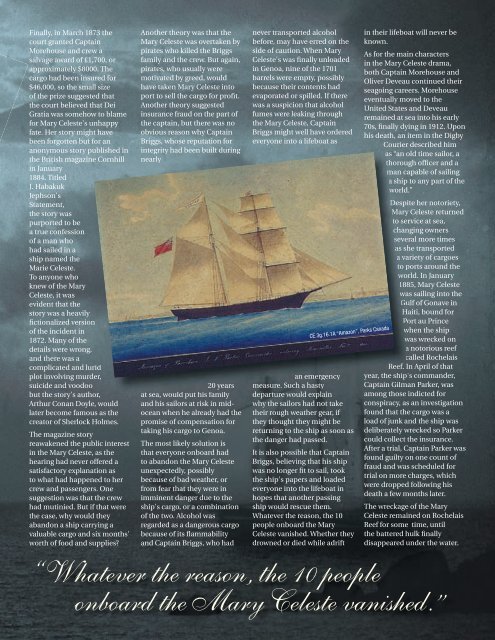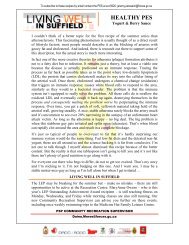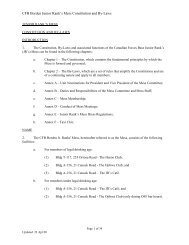We Care!
We Care!
We Care!
You also want an ePaper? Increase the reach of your titles
YUMPU automatically turns print PDFs into web optimized ePapers that Google loves.
Finally, in March 1873 the<br />
court granted Captain<br />
Morehouse and crew a<br />
salvage award of £1,700, or<br />
approximately $8000. The<br />
cargo had been insured for<br />
$46,000, so the small size<br />
of the prize suggested that<br />
the court believed that Dei<br />
Gratia was somehow to blame<br />
for Mary Celeste's unhappy<br />
fate. Her story might have<br />
been forgotten but for an<br />
anonymous story published in<br />
the British magazine Cornhill<br />
in January<br />
1884. Titled<br />
J. Habakuk<br />
Jephson's<br />
Statement,<br />
the story was<br />
purported to be<br />
a true confession<br />
of a man who<br />
had sailed in a<br />
ship named the<br />
Marie Celeste.<br />
To anyone who<br />
knew of the Mary<br />
Celeste, it was<br />
evident that the<br />
story was a heavily<br />
fictionalized fictionalized version<br />
of the incident in<br />
1872. Many of the<br />
details were wrong,<br />
and there was a<br />
complicated and lurid<br />
plot involving murder,<br />
suicide and voodoo<br />
but the the story's author,<br />
Arthur Conan Doyle, would<br />
later become famous as the<br />
creator of Sherlock Holmes.<br />
The magazine story<br />
reawakened the public interest<br />
in the Mary Celeste, as the<br />
hearing had never offered a<br />
satisfactory explanation as<br />
to what had happened to her<br />
crew and passengers. One<br />
suggestion was that the crew<br />
had mutinied. But if that were<br />
the case, why would they<br />
abandon a ship carrying a<br />
valuable cargo and six months'<br />
worth of food and supplies?<br />
Another theory was that the<br />
Mary Celeste was overtaken by<br />
pirates who killed the Briggs<br />
family and the crew. But again,<br />
pirates, who usually were<br />
motivated by greed, would<br />
have taken Mary Celeste into<br />
port to sell the cargo for profit.<br />
Another theory suggested<br />
insurance fraud on the part of<br />
the captain, but there was no<br />
obvious reason why Captain<br />
Briggs, whose reputation for<br />
integrity had had been built during<br />
nearly<br />
20 years<br />
at sea, would put his family family<br />
and his sailors at risk in midocean<br />
when he already had the<br />
promise of compensation for<br />
taking his cargo to Genoa.<br />
The most likely solution is<br />
that everyone onboard had<br />
to abandon the Mary Celeste<br />
unexpectedly, possibly<br />
because of bad weather, or<br />
from fear that they were in<br />
imminent danger due to the<br />
ship's cargo, or a combination<br />
of the two. Alcohol was<br />
regarded as a dangerous cargo<br />
because of its flammability<br />
and Captain Briggs, who had<br />
never transported alcohol<br />
before, may have erred on the<br />
side of caution. When Mary<br />
Celeste's was finally unloaded<br />
in Genoa, nine of the 1701<br />
barrels were empty, possibly<br />
because their contents had<br />
evaporated or spilled. If there<br />
was a suspicion that alcohol<br />
fumes were leaking through<br />
the Mary Celeste, Captain<br />
Briggs might well have ordered<br />
everyone into a lifeboat as<br />
an emergency<br />
emergency<br />
measure. Such a hasty<br />
departure would explain<br />
why the sailors had not take<br />
their rough weather gear, if<br />
they thought they might be<br />
returning to the ship as soon as<br />
the danger had passed.<br />
It is also possible that Captain<br />
Briggs, believing that his ship<br />
was no longer fit to sail, took<br />
the ship's papers and loaded<br />
everyone into the lifeboat in<br />
hopes that another passing<br />
ship would rescue them.<br />
Whatever the reason, the 10<br />
people onboard the Mary<br />
Celeste vanished. Whether they<br />
drowned or died while adrift<br />
in their lifeboat will never be<br />
known.<br />
As for the main characters<br />
in the Mary Celeste drama,<br />
both Captain Morehouse and<br />
Oliver Deveau continued their<br />
seagoing careers. Morehouse<br />
eventually moved to the<br />
United States and Deveau<br />
remained at sea into his early<br />
70s, finally dying in 1912. Upon<br />
his death, an item in the Digby<br />
Courier described him<br />
as “an old time sailor, a<br />
thorough officer and a<br />
man man capable of sailing<br />
a ship to any part of the<br />
world.”<br />
Despite Despite her notoriety,<br />
Mary Celeste returned<br />
to service at sea,<br />
changing owners<br />
several more times<br />
as she transported<br />
a variety of cargoes<br />
to ports around the<br />
world. In January<br />
1885, Mary Celeste<br />
was sailing into the<br />
Gulf of Gonave in<br />
Haiti, bound for<br />
Port au Prince<br />
when the ship<br />
was wrecked on<br />
a notorious reef<br />
called Rochelais<br />
Reef. In April of that<br />
year, the ship's commander,<br />
Captain Gilman Parker, was<br />
among those indicted for<br />
conspiracy, as an investigation<br />
found that the cargo was a<br />
load of junk and the ship was<br />
deliberately wrecked so Parker<br />
could collect the insurance.<br />
After a trial, Captain Parker was<br />
found guilty on one count of<br />
fraud and was scheduled for<br />
trial on more charges, which<br />
were dropped following his<br />
death a few months later.<br />
The wreckage of the Mary<br />
Celeste remained on Rochelais<br />
Reef for some time, until<br />
the battered hulk finally<br />
disappeared under the water.<br />
“Whatever the reason, the 10 people<br />
onboard the Mary Celeste vanished.”
















